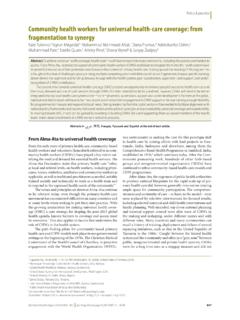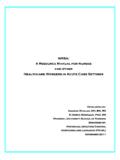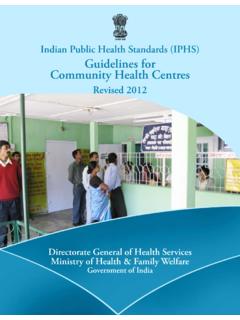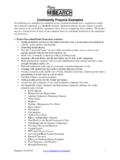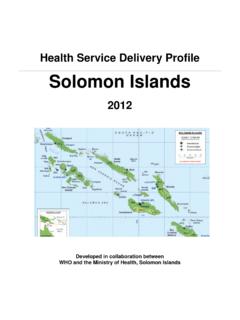Transcription of Improving the Safety and Health of Young Workers
1 Improving the Safety and Health of Young Workers 28 April 2018. World Day GENERATIONHEALTHY. For Safety and Health at Work SAFE&. Improving the Safety and Health of Young Workers Copyright International Labour Organization 2018 The designations employed in ILO publications, which are First published (2018) in conformity with United Nations practice, and the presen- tation of material therein do not imply the expression of any Publications of the International Labour Office enjoy copy- opinion whatsoever on the part of the International Labour right under Protocol 2 of the Universal Copyright Convention. Office concerning the legal status of any country, area or Nevertheless, short excerpts from them may be reproduced territory or of its authorities, or concerning the delimitation of without authorization, on condition that the source is indi- its frontiers. cated. For rights of reproduction or translation, application should be made to ILO Publications (Rights and Licensing), The responsibility for opinions expressed in signed articles, International Labour Office, CH-1211 Geneva 22, Switzerland, studies and other contributions rests solely with their authors, or by email: The International Labour Office and publication does not constitute an endorsement by the welcomes such applications.
2 International Labour Office of the opinions expressed in them. Libraries, institutions and other users registered with a repro- duction rights organization may make copies in accordance Reference to names of firms and commercial products and with the licences issued to them for this purpose. Visit www. processes does not imply their endorsement by the Interna- to find the reproduction rights organization in your tional Labour Office, and any failure to mention a particular country. firm, commercial product or process is not a sign of disap- proval. ISBN: 978-92-2-131650-3 (print). ISBN: 978-92-2-131651-0 (web pdf) Information on ILO publications and digital products can be found at: This publication is also available in French and Spanish. Funding for this report was provided by the United States Credits Department of Labor under Cooperative Agreement Page 2 (top), 6, 9, 22, 24, 27, 30, 37: Maxime Fossat ILO number IL-26690-14-75-K-11. This report does not necessarily Page 2 (middle), 18 (top left): Nadia Bseiso ILO reflect the views or policies of the United States Department Page 8, 12, 15, 18 (top right, middle left), 20: ILO of Labor, nor does mention of trade names, commercial Page 11: Yo.
3 Nyamdavaa ILO products, or organizations imply endorsement by the United Page 17: Wei Xiangnan ILO States Government. Page 18 (top middle), 29: Nguyen Viet Thanh ILO. Page 18 (middle right): A. DOW ILO. Page 18 (bottom left, bottom right), 32: Marcel Crozet ILO. Page 18 (bottom middle): Thierry Falise ILO. Page 38, 39: Steve Lim ILO. 4. Table of contents Introduction 7. What do we mean by Young Workers ? 10. Factors threatening the Safety and Health of Young Workers 11. Risk factors that are specific to Young Workers 12. Work hazards to which Young Workers are frequently exposed 14. Young Workers in hazardous economic sectors 18. International labour standards that protect the Safety and Health of Young Workers 20. OSH standards that protect Young Workers 21. undamental standards pertaining to the elimination F. of child labour 23. A framework for national and regional action regarding OSH for Young Workers 24. I mproving the collection and analysis of data and information on OSH and Young Workers 26.
4 Eveloping, updating and implementing laws, D. regulations, policies and guidelines to better protect the Safety and Health of Young Workers 28. apacity building aimed at helping governments, C. employers, Workers and their organizations address the OSH needs of Young Workers 32. I ntegrating OSH into general education and vocational training programs, so as to build a safer and healthier generation of Workers 34. trengthening advocacy, awareness and research S. on Young Workers ' vulnerability to OSH hazards and risks 36. Youth participation in the creation of an OSH. culture of prevention 38. 5. 6 Introduction According to the latest estimates released by the International Labour Organization (ILO), million Workers die every year due to occupational accidents and work-related dis- Some million ( per cent) of these deaths are due to work-related diseases, while over 380,000 ( per cent) result from occupational accidents. Each year, there are almost a thousand times more non-fatal occupational injuries than fatal occupational injuries.
5 Non-fatal injuries are estimated to affect 374 million Workers annually, and many of these injuries have serious consequences for Workers ' earning capacity in the long term (H m l inen et al., 2017). Young Workers have significantly higher rates of occupational injury than do adult work- ers. According to recent European data, the incidence of non-fatal injury at work was more than 40 per cent higher among Young Workers between the ages of 18 and 24 than among adult Workers (EU-OSHA, 2007). In the United States, the risk that Young Workers between the ages of 15 and 24 will suffer a non-fatal occupational injury is approximately twice as high as that for Workers age 25 or older (CDC, 2010). Paradoxically, in view of the above, statistics indicate that the incidence of occupational diseases is lower among Young Workers than among older Workers . This is not due to Young Workers having greater resistance to occupational diseases. Young Workers are in fact more vulnerable to occupational diseases because they are still developing, both physically and mentally, and this makes them more susceptible to harm from hazardous chemicals and other agents.
6 The lower incidence of occupational diseases among Young Workers is most likely due to the fact that occupational diseases often occur only after cumulative exposure and/or a latency period. Moreover, it is difficult to obtain accurate data on occupational diseases, and this is particularly the case with data on occupational diseases caused by the exposure to workplace hazards during youth (EU-OSHA, 2007). As well as causing incalculable human suffering, occupational accidents and diseases con- stitute a significant economic cost, amounting to an estimated annual loss of per cent of global GDP (ILO, 2017c). The cost to society of Young Workers being seriously injured and experiencing long-term impairment as a result can be much greater than the cost to society of adult Workers sustaining similar injuries. The consequences of occupational inju- ries are more serious when these injuries occur at the beginning of a Young person's work- ing life. A Young worker with a long-term impairment could cease to be an active member of society and make little use of the education and training that they have received.
7 1. In 1987, the Joint ILO/WHO Committee on Occupational Health suggested that the term work-related diseases . be used to describe not only recognized occupational diseases, but also other disorders to which the work environment and p erformance of work contribute significantly. For more information about the methodology used for producing global estimates and the criteria employed for the inclusion of work-related diseases, please consult the publication Global Estimates of O. ccupational Accidents and Work-Related Illnesses 2017 (H m l inen et al., 2017). 7. Many countries are making significant investments in Young people's employment, educa- tion, training, skills development and job creation. It is critically important to include occu- pational Safety and Health (OSH) in these programmes. In order to do so, it is necessary to understand and address the Safety and Health risk factors faced by Young Workers between the ages of 15 and 24. Young Workers under the age of 18 are recognized in law and policy as a vulnerable group and provided with special protections under child labour standards and hazardous work prohibitions, but those between the ages of 18 and 24 do not receive comparable legal recognition or levels of protection in the workplace, despite their con- tinuing and increased risk of injury.
8 The ILO has a long-standing commitment to the promotion of decent work and safe and healthy working conditions for all Workers , throughout their working lives. It stresses the importance of Improving OSH for Young Workers , both in order to promote decent youth employment and in order to contribute to efforts aimed at combatting hazardous child Of the million children engaged in child labour globally, almost half ( million) are engaged in hazardous child labour. Some 24 per cent (over 37 million) are be- tween the ages of 15 and 17 (ILO, 2017b). Taking serious steps to address OSH for Young Workers has two benefits: Improving the Health and Safety of Young Workers and reducing the number of children engaged in hazardous child labour. 2. The worst forms of child labour, as defined in ILO Convention No. 182, include work which, by its nature or the circum- stances in which it is carried out, is likely to harm the Health , Safety or morals of children.. 8. What is the Purpose of this ILO Brief?
9 The ILO has prepared this brief for the 2018 World Day for Safety and Health at Work, which aims to promote a safe and healthy generation. The goals of the brief are to describe the OSH risks faced by Young Workers and to encourage a global conversation on the need to improve their Safety and Health . The brief analyses the factors that increase the work-related risks that Young Workers face and describes legal, policy and practical steps for improvement. To build a generation of safe and healthy Workers , preparation must begin early, starting with parental and community awareness. For Young people to be aware of risks and able to advocate on their own behalf, education about work hazards and risks, as well as about Workers rights, needs to start in school and continue through vocational training and ap- prenticeship programmes. Employers, including both formal and informal enterprises, and family businesses, need guidance on the risk factors that Young Workers face and on work tasks and conditions that are age-appropriate.
10 Lastly, support and representation by work- ers' organizations, as Young people enter the world of work, is essential if Young Workers are to be able to exercise their rights and voice their concerns. Improving the Safety and Health of Young Workers will contribute to the achievement of Sustainable Development Goal (SDG) 8 on decent work and economic growth. This will help us in reaching Target on safe and secure working environments for all Workers by 2030, and Target on ending all forms of child labour by 2025. Reaching these targets requires that public authorities, employers, Workers and their organizations, and other key stakeholders collaborate to create a culture of prevention that focuses on the Safety and Health of the next generation of the global workforce. 9. What do we mean by Young Workers ? The United Nations (UN), for statistical purposes, de- Young Workers exhibit varied levels of cognitive, fines youth as persons between the ages of 15 and psychosocial and physical development.











